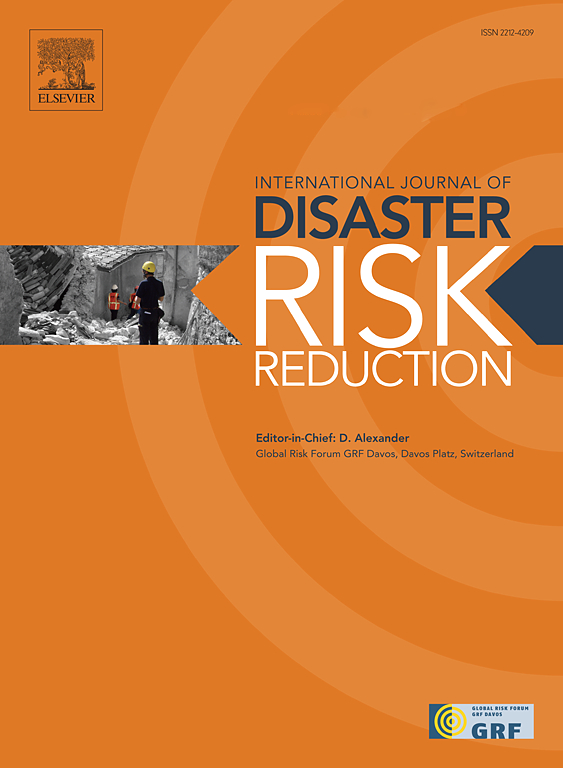A tool to assess road interruption due to earthquake-induced collapse of infill walls in RC buildings
IF 4.5
1区 地球科学
Q1 GEOSCIENCES, MULTIDISCIPLINARY
International journal of disaster risk reduction
Pub Date : 2025-07-16
DOI:10.1016/j.ijdrr.2025.105707
引用次数: 0
Abstract
Roads are essential for both normal transportation and emergency operations, but earthquakes can block them by damaging structures and causing debris to fall onto the pavement. Recent studies show that the debris from both structural and non-structural components can spread beyond a building's footprint, sometimes occupying a significant portion of the adjacent road. When this happens, emergency services may not be able to pass, and evacuation routes can become unusable or much harder to cross. However, much of the literature focuses on broad estimates or on masonry buildings, and there is still a need for tools that more precisely capture the behaviour of reinforced concrete structures with infill walls, especially when looking at different construction periods, building heights, and infill typologies.
This article proposes a new tool for estimating the debris produced by infill wall collapse in reinforced concrete buildings under seismic actions. The tool is based on nonlinear dynamic analyses of buildings with various heights, ages, and infill wall types. It aims to quantify, at increasing levels of seismic intensity, the volumes of collapsed material and the distance this material can project onto nearby roads. This information is crucial for assessing the possible obstructions to emergency vehicles and for improving the resilience of urban areas after an earthquake. By examining buildings of different characteristics, the proposed approach offers a more detailed understanding of how infill walls behave during seismic events and how this can affect traffic flow, rescue operations, and overall accessibility in critical post-earthquake conditions.
一种评估钢筋混凝土建筑物内填充墙因地震引起的倒塌而导致道路中断的工具
道路对于正常的交通运输和紧急行动都是必不可少的,但地震会破坏建筑物并导致碎片落在人行道上,从而阻碍道路的发展。最近的研究表明,结构和非结构部件的碎片可能会蔓延到建筑物的足迹之外,有时会占据邻近道路的很大一部分。当这种情况发生时,紧急服务可能无法通过,疏散路线可能变得无法使用或更难通过。然而,大部分文献都集中在广泛的估计或砖石建筑上,仍然需要更精确地捕捉带有填充墙的钢筋混凝土结构的行为的工具,特别是在观察不同的施工周期、建筑高度和填充类型时。本文提出了一种估算地震作用下钢筋混凝土建筑填充墙倒塌产生的碎片的新工具。该工具基于各种高度、年龄和填充墙类型的建筑物的非线性动态分析。它的目的是量化,随着地震强度的增加,坍塌材料的体积和这些材料可以投射到附近道路的距离。这些信息对于评估紧急车辆可能遇到的障碍和提高城市地区在地震后的复原力至关重要。通过研究不同特征的建筑物,所提出的方法可以更详细地了解填充墙在地震事件中的行为,以及这如何影响交通流量、救援行动和震后关键条件下的整体可达性。
本文章由计算机程序翻译,如有差异,请以英文原文为准。
求助全文
约1分钟内获得全文
求助全文
来源期刊

International journal of disaster risk reduction
GEOSCIENCES, MULTIDISCIPLINARYMETEOROLOGY-METEOROLOGY & ATMOSPHERIC SCIENCES
CiteScore
8.70
自引率
18.00%
发文量
688
审稿时长
79 days
期刊介绍:
The International Journal of Disaster Risk Reduction (IJDRR) is the journal for researchers, policymakers and practitioners across diverse disciplines: earth sciences and their implications; environmental sciences; engineering; urban studies; geography; and the social sciences. IJDRR publishes fundamental and applied research, critical reviews, policy papers and case studies with a particular focus on multi-disciplinary research that aims to reduce the impact of natural, technological, social and intentional disasters. IJDRR stimulates exchange of ideas and knowledge transfer on disaster research, mitigation, adaptation, prevention and risk reduction at all geographical scales: local, national and international.
Key topics:-
-multifaceted disaster and cascading disasters
-the development of disaster risk reduction strategies and techniques
-discussion and development of effective warning and educational systems for risk management at all levels
-disasters associated with climate change
-vulnerability analysis and vulnerability trends
-emerging risks
-resilience against disasters.
The journal particularly encourages papers that approach risk from a multi-disciplinary perspective.
 求助内容:
求助内容: 应助结果提醒方式:
应助结果提醒方式:


